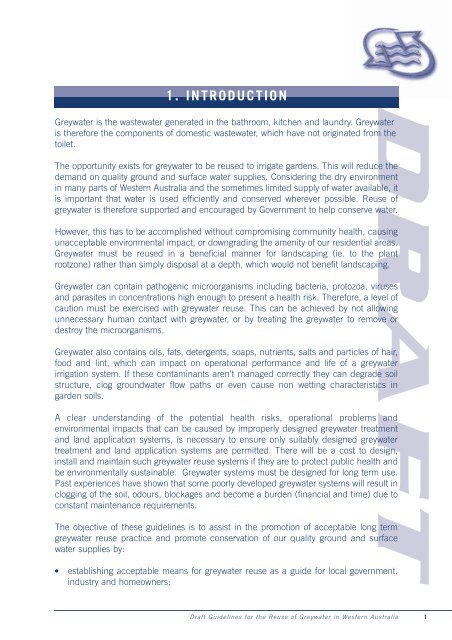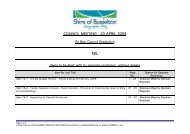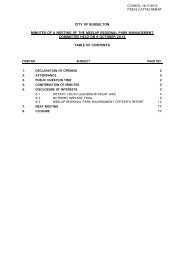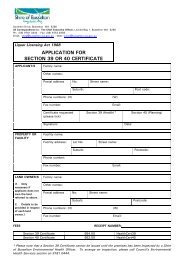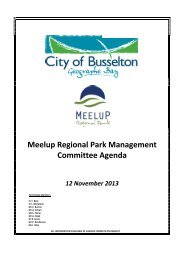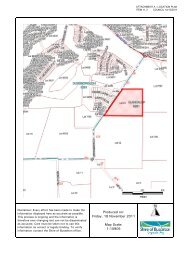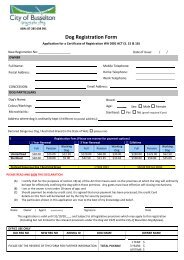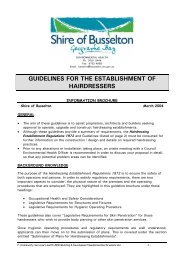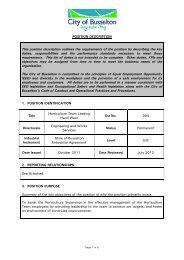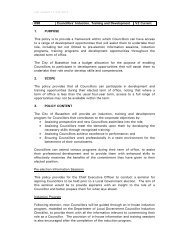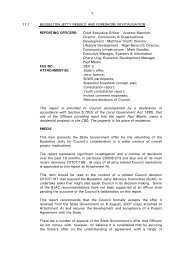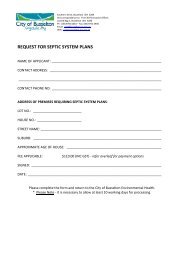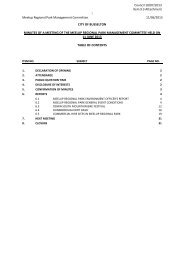Draft Guidelines for the Reuse of Greywater in Western Australia
Draft Guidelines for the Reuse of Greywater in Western Australia
Draft Guidelines for the Reuse of Greywater in Western Australia
You also want an ePaper? Increase the reach of your titles
YUMPU automatically turns print PDFs into web optimized ePapers that Google loves.
1. INTRODUCTION<br />
<strong>Greywater</strong> is <strong>the</strong> wastewater generated <strong>in</strong> <strong>the</strong> bathroom, kitchen and laundry. <strong>Greywater</strong><br />
is <strong>the</strong>re<strong>for</strong>e <strong>the</strong> components <strong>of</strong> domestic wastewater, which have not orig<strong>in</strong>ated from <strong>the</strong><br />
toilet.<br />
The opportunity exists <strong>for</strong> greywater to be reused to irrigate gardens. This will reduce <strong>the</strong><br />
demand on quality ground and surface water supplies. Consider<strong>in</strong>g <strong>the</strong> dry environment<br />
<strong>in</strong> many parts <strong>of</strong> <strong>Western</strong> <strong>Australia</strong> and <strong>the</strong> sometimes limited supply <strong>of</strong> water available, it<br />
is important that water is used efficiently and conserved wherever possible. <strong>Reuse</strong> <strong>of</strong><br />
greywater is <strong>the</strong>re<strong>for</strong>e supported and encouraged by Government to help conserve water.<br />
However, this has to be accomplished without compromis<strong>in</strong>g community health, caus<strong>in</strong>g<br />
unacceptable environmental impact, or downgrad<strong>in</strong>g <strong>the</strong> amenity <strong>of</strong> our residential areas.<br />
<strong>Greywater</strong> must be reused <strong>in</strong> a beneficial manner <strong>for</strong> landscap<strong>in</strong>g (ie. to <strong>the</strong> plant<br />
rootzone) ra<strong>the</strong>r than simply disposal at a depth, which would not benefit landscap<strong>in</strong>g.<br />
<strong>Greywater</strong> can conta<strong>in</strong> pathogenic microorganisms <strong>in</strong>clud<strong>in</strong>g bacteria, protozoa, viruses<br />
and parasites <strong>in</strong> concentrations high enough to present a health risk. There<strong>for</strong>e, a level <strong>of</strong><br />
caution must be exercised with greywater reuse. This can be achieved by not allow<strong>in</strong>g<br />
unnecessary human contact with greywater, or by treat<strong>in</strong>g <strong>the</strong> greywater to remove or<br />
destroy <strong>the</strong> microorganisms.<br />
<strong>Greywater</strong> also conta<strong>in</strong>s oils, fats, detergents, soaps, nutrients, salts and particles <strong>of</strong> hair,<br />
food and l<strong>in</strong>t, which can impact on operational per<strong>for</strong>mance and life <strong>of</strong> a greywater<br />
irrigation system. If <strong>the</strong>se contam<strong>in</strong>ants aren’t managed correctly <strong>the</strong>y can degrade soil<br />
structure, clog groundwater flow paths or even cause non wett<strong>in</strong>g characteristics <strong>in</strong><br />
garden soils.<br />
A clear understand<strong>in</strong>g <strong>of</strong> <strong>the</strong> potential health risks, operational problems and<br />
environmental impacts that can be caused by improperly designed greywater treatment<br />
and land application systems, is necessary to ensure only suitably designed greywater<br />
treatment and land application systems are permitted. There will be a cost to design,<br />
<strong>in</strong>stall and ma<strong>in</strong>ta<strong>in</strong> such greywater reuse systems if <strong>the</strong>y are to protect public health and<br />
be environmentally susta<strong>in</strong>able. <strong>Greywater</strong> systems must be designed <strong>for</strong> long term use.<br />
Past experiences have shown that some poorly developed greywater systems will result <strong>in</strong><br />
clogg<strong>in</strong>g <strong>of</strong> <strong>the</strong> soil, odours, blockages and become a burden (f<strong>in</strong>ancial and time) due to<br />
constant ma<strong>in</strong>tenance requirements.<br />
The objective <strong>of</strong> <strong>the</strong>se guidel<strong>in</strong>es is to assist <strong>in</strong> <strong>the</strong> promotion <strong>of</strong> acceptable long term<br />
greywater reuse practice and promote conservation <strong>of</strong> our quality ground and surface<br />
water supplies by:<br />
●<br />
establish<strong>in</strong>g acceptable means <strong>for</strong> greywater reuse as a guide <strong>for</strong> local government,<br />
<strong>in</strong>dustry and homeowners;<br />
DRAFT<br />
<strong>Draft</strong> <strong>Guidel<strong>in</strong>es</strong> <strong>for</strong> <strong>the</strong> <strong>Reuse</strong> <strong>of</strong> <strong>Greywater</strong> <strong>in</strong> <strong>Western</strong> <strong>Australia</strong><br />
1


